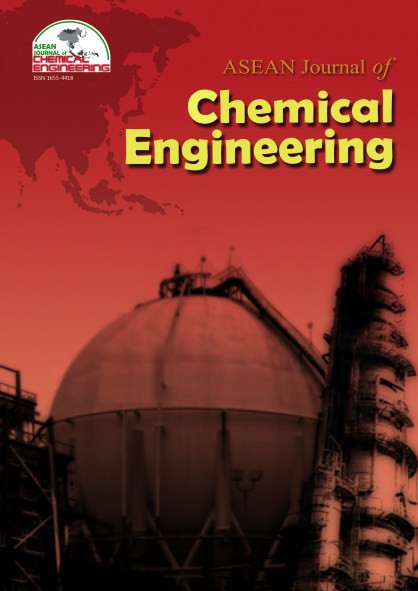Kinetic Analysis of Phenol Biodegradation by Isolated Bacteria and Mixed Culture by Cells Immobilized on Loofa (Lugga Cylindrica) Sponge in Airlift Bioreactior
Abstract
Varios contaminated soil samples were examined for isolation of microorganisms responsible for phinol degradation. One type pure culture gram positive bacterua was isolated and identified as Bacillus pulvifaciens. isolated bacteria and an activated sludge were acclimated for 75 days to a medium containing phenol is a speratae 250 ml Erlenmeyer flasks. After this period of time, biomass was transferred into airlift bioreactor with looga sponge for cells immobilization and acclimation which was operated by fill and draw moder faro 70 days. The immobilized cells gres wthin the void space of the loofa spongem reaching a high cells concentration of 21.4 g-calees/l-sponge volume and the free cells in the effluent became arround of 0.7 g/l. The performance of airlift bioreactir for 27 hours operation after acclimation period, showed that decrease in phenol concentration after 24th hour culture with isolated bacteria and the activated sludge culture were 99.8% and 84,2% removal, respectivaly. The phenol and COD degradation by the isolated bacteria was higher than that of the activated sludge culture. Based on the experimental data, kinetic model was discussed. through the model the biokinetic paramters were evaluated, which represented the behavior of eractor very well.References
Cooper, V.A. & J.A. Nicell, Wat. Res., Removal of phenols from a foundry wastewater using horseradish peroxidase, Wat. Res. 30, 954-964, 1996.
Faisal, Sreening of microbial degradation of phenol from various soil, Proceeding seminar on science and technology, 2000, Padang, Indonesia.
Lazarova, V., R. Nogueira, J. Manem and L. Melo, Control of Nitification efficiency in a new biofilm reactor, Wat. Sci. 36, 1, 31-41, 1997.
Hold J.G., N.R. Krieg, P.H.A. Sneath, J.T. Staley & S.T. William, Bergey,s manual of determinative bacteriology, ninth edition, Williams & Wilkins, Baltimoro, 1994.
Kumaran, P. & Y.L. Paruchuri, Kinetic of phenol biotransformation, Wat Res. 31, 11-22. 1997.
James, C. O., Y.C Liu., Y.K Liu, and H. Tanaka, Loofa (Luffa cylindrical) spone as a carrier for microbial cell immobilization, Journal of Fermentation and Bioengineering, 78, 6, 437-442, 1994.
Luca, M., G. Paola, M. Liberato and S. Giovanni, Reduction of phenol content and toxicity in olive oil mill wastewater with the ligninolytic fungus Pleurotus ostreatus, Wat. Res. 30, 8, 1914-1918, 1996.
Ogbona, J.C., T. Shota, L. Ying-Chun and T. Hideo, Efficient production of ethanol by cells immobilized in loofa (luffa cylindrical) sponge, J. Fermentation and Bioengineering, 84, 3, 271-274, 1977.
Salter, G.J., D.B. Keel, 1. A. Ash, J.M.Adams, A.J. Brown and B. Atkinson, (1990), Hydrodynamic deposition: a novel method of cell immobilization, Enzyme Microb. Technol., 12, 419-430, 1990.
Xing, X.H., T.Inoue, Y. Tanji and H.Unno, Enhanced microbial adaptation to p-nitrophenol using activated sludge retained in porous carrier particles and simultaneous removal of nitrite released from degradation of p-nitrophenol, Jurnal of Bioscience and Bioengineering, 87, 3, 372-377, 1999.
Yimin Wu, E.T. Keith, Nihar Biswas & K.B. Jatinder, Comparison of additives in the removal of phenolic compounds by peroxidase-catalyzed polymerization, Wat. Res. 31, 2699-2704, 1997.
Copyright holder for articles is ASEAN Journal of Chemical Engineering. Articles published in ASEAN J. Chem. Eng. are distributed under a Creative Commons Attribution-NonCommercial 4.0 International (CC BY-NC 4.0) license.
Authors agree to transfer all copyright rights in and to the above work to the ASEAN Journal of Chemical Engineering Editorial Board so that the Editorial Board shall have the right to publish the work for non-profit use in any media or form. In return, authors retain: (1) all proprietary rights other than copyright; (2) re-use of all or part of the above paper in their other work; (3) right to reproduce or authorize others to reproduce the above paper for authors’ personal use or for company use if the source and the journal copyright notice is indicated, and if the reproduction is not made for the purpose of sale.



